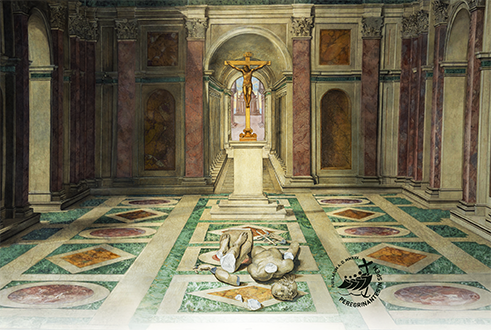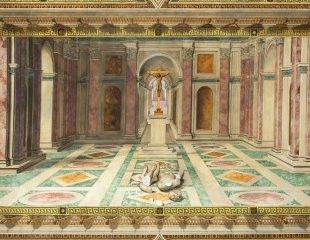
From Raphael to Laureti
The restoration of the Hall of Constantine
Vatican Museums
Almost ten years after the beginning of work, the Vatican Museums present the conclusion of the long and complex restoration of the pictorial cycle of the Hall of Constantine, the largest of the Raphael’s Rooms.
The conservation work, which began in March 2015 on the east wall, dominated by the scene with the Vision of the Cross, was completed in December 2024 with the restoration of the large painted tapestry that overlooks the entire decoration from the centre of the vault.
The entire project was coordinated by the Department of XV-XVI Century Art, and was carried out by the Painting and Wood Materials Restoration Laboratory in collaboration with the Cabinet of Scientific Research, with the generous support of the Patrons of the Arts in the Vatican Museums, New York Chapter.
The cleaning of the paintings, with the recovery of the formal and aesthetic values of the entire decoration of the walls and the vault, highlighted multiple themes of historical, critical and technical reflection regarding the methods of its execution, complex and stimulating themes that constitute a sort of watershed in studies of Raphael, his workshop, and the major artistic atelier of the 16th century.
The Hall of Constantine is referred to in documents as the Aula pontificum superior, to distinguish it from the Aula pontificum inferior, located on the floor below, in the Borgia Apartment. Intended for official ceremonies such as the consistory or solemn wedding banquets, it was thus named in honour of the Roman emperor who granted freedom of worship to Christians and was decorated in several phases: during the Medici pontificates of Leo X (1513-1521) and Clement VII (1523-1534), to which we can date the oil paintings on the wall by Raphael with Comitas and Iustitia and the monumental frescoes on the walls executed by his workshop, led by Giulio Romano and Giovan Francesco Penni, depicting the Vision of the Cross (or Adlocutio), the Battle of Pons Milvius, the Baptism of Constantine and the Donation of Rome; during the papacy of Paul III Farnese (1534-1549), to which some of the works by Sebastiano del Piombo are attributed; and finally, during the pontificates of Gregory XIII Boncompagni (1572-1585) and Sixtus V Peretti (1585-1590), which saw the decoration of the ceiling by Tommaso Laureti, pupil of Sebastiano del Piombo and here the author of the iconic Triumph of Christianity over Paganism. Today the two extraordinary oil-painted figures by the master of Urbino, the monumentality of the scenes on the walls, the skilful play of visual deception devised by Laureti with the vault paintings, of which the false tapestry at the centre constitutes a supreme masterpiece of illusionist perspective, in their entirety, although inconsistent in style, allow us to appreciate the unparalleled decorative and iconographic variety of the room after their complete restoration.
At the end of the decade-long restoration of the pictorial cycle of the Hall of Constantine, it can be affirmed without any doubt that the wall paintings, the two figures painted in oil by Raphael and the four frescoes by Giulio Romano and del Penni, his collaborators, together with the subsequent decoration of the ceiling by Laureti, represent in their different painterly approaches a renewed and extraordinary record, a true palimpsest, of painting in Rome from the first to the last decades of the 16th century.
























